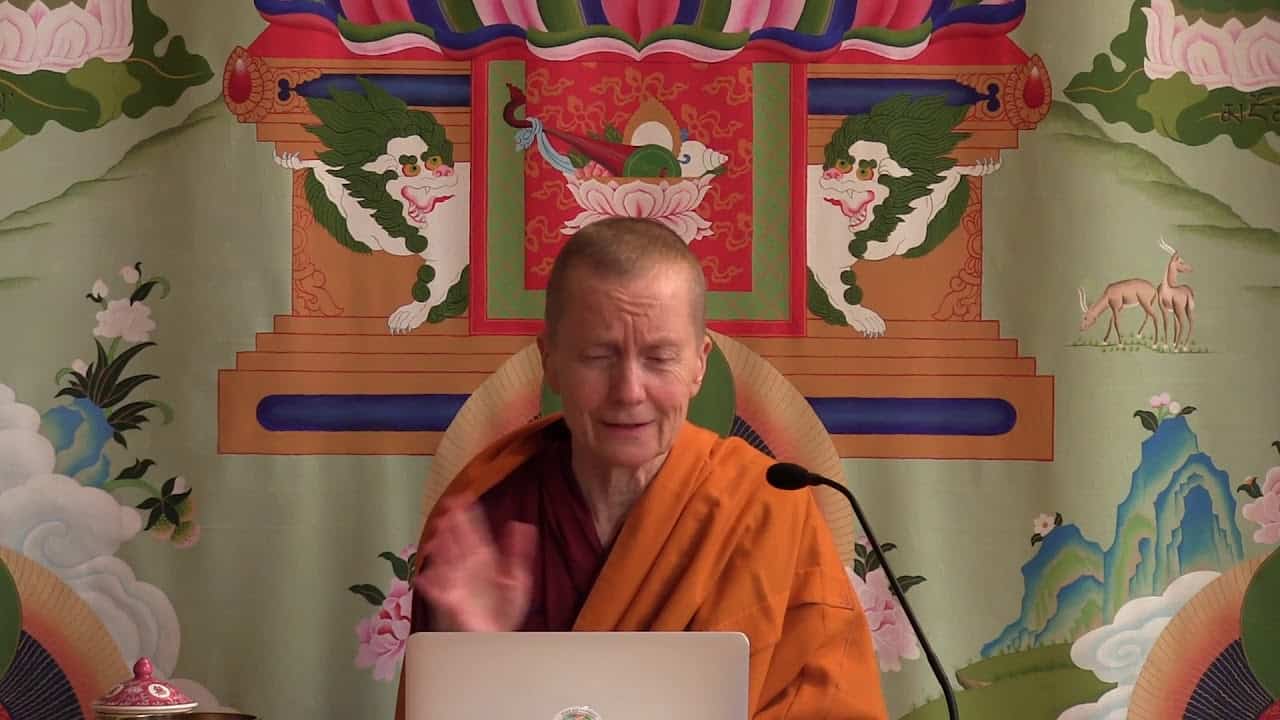Meditation outline for “The Eight Verses of Thought Transformation”
Meditation outline for “The Eight Verses of Thought Transformation”

“The Eight Verses of Thought Transformation” as a basis for meditation.
The four noble truths
These four truths describe our current situation as well as our potential:
- We experience suffering, difficulties and problems
- These have causes: ignorance, attachment and aversion
- It is possible to cease these completely
- There is a path to do so
Mind is the source of happiness and pain
- Remember a disturbing situation in your life. Recall what you were thinking and feeling. Examine how your attitudes created your perception and experience.
- Examine how your attitude affected what you said and did in the situation.
- Was your attitude realistic? Was it seeing all sides of the situation or was it viewing things through the eyes of “me, I, my and mine?”
- Think of how else you could have viewed the situation and how that would have changed your experience of it.
Conclusion: Determine to be aware of how you’re interpreting events in your life and to cultivate beneficial and realistic ways of looking at them.
Working with anger
Anger (or aversion) can arise towards people, objects or our own suffering (e.g. when we’re sick). It arises due to exaggerating the negative qualities of a person, object or situation, or by superimposing negative qualities that aren’t there. Anger then wants to harm the source of the unhappiness. Anger (aversion) is a generic term which includes being irritated, annoyed, critical, judgmental, self-righteous, belligerent and hostile.
Patience is the ability to remain undisturbed in confront of harm or suffering. Being patient does not mean being passive. Rather, it gives the clarity of mind necessary to act or not act.
By reflecting your own experiences, examine if anger is destructive or useful. Check:
- Am I happy when I’m angry?
- Do I communicate with others effectively when I’m angry?
- How do I act when I’m angry? What is the effect of my actions on others?
- Later when I’m calm, do I feel good about what I said and did when I was angry? Or, is there a sense of shame or remorse?
- How do I appear in others’ eyes when I’m angry? Does anger promote mutual respect, harmony, and friendship?
Transforming anger
- Usually we look at a situation from the viewpoint of our own needs and interests and believe how the situation appears to us is how it objectively exists. Now put yourself in the other’s shoes and ask, “What are my (i.e. the other’s) needs and interests?” View the situation from the other’s eyes.
- Look at how your “old” self appears in the eyes of the other. We can sometimes understand why others react to us the way they do and how we unwittingly increase the conflict.
- Remember that the other person is unhappy. Their wish to be happy is what motivates them to do whatever it is that disturbs us. We know what it’s like to be unhappy: try to develop compassion for this person who is unhappy, but who is exactly like us in wanting happiness and not wanting pain.
Taking the ache out of attachment
Attachment is an attitude that exaggerates or superimposes good qualities on a person, object, idea, etc. and then clings to that as the source of our happiness. Reflect:
- What things, people, ideas, etc. am I attached to?
- How does that person or thing appear to me? Does he/she/it really have all the qualities I’m perceiving and attributing?
- Do I develop unreal expectations of the person or thing, thinking that he/she/it will always be there, will continuously make me happy, etc.?
- How does my attachment make me act? For example, do I disregard my ethical standards to get what I’m attached to? Do I get into dysfunctional relationships?
- Look at the person or thing in a more balanced way. Note its changeable nature, its weaknesses, and its natural limits to bring you happiness.
The eight worldly concerns
Examine how the following attitudes operate in your life. Do they make you happy or confused? Do they help you grow or do they keep you in prison? How else could you look at the situation so that these disturbing attitudes wouldn’t arise?
- 1&2. Attachment to receiving material possessions, aversion to not receiving or being separated from them.
- 3&4. Attachment to praise or approval, aversion to blame or disapproval.
- 5&6. Attachment to a good reputation (having a good image, others thinking well of you), aversion to a bad one.
- 7&8. Attachment to pleasures of the five senses, aversion to unpleasant experiences.
Conclusion: Determine to be more mindful in your daily life, not just living “on automatic,” chasing after some worldly concerns and fearing others. Determine to develop more balanced attitudes so you can make wise choices in life.
Equanimity
- Visualize three people: a friend, someone you have difficulty with, and a stranger. Ask yourself, “Why do I feel attachment for the friend, aversion toward the enemy, and apathy for the stranger?” Listening to the answers your mind gives, explore whether your views of others are biased or realistic.
- Contemplate that the relationships of friend, difficult person, and stranger change constantly. One person can be all three within a short period of time. Therefore, being attached to some people, averse to others, and indifferent to some doesn’t make sense.
Conclusion: Acknowledging that your attitudes create the seeming solid relationships of friend, enemy, and stranger, let go of the attachment, anger, and apathy towards them. Let yourself feel an open-hearted concern for all.
Verse 1: Seeing all beings as precious and holding them dear
Recognize that you’ve received incalculable benefit and help from others throughout your lifetime:
- Contemplate the help you’ve received from friends and relatives: education, care when you were young or sick, encouragement and support, constructive criticism, etc.
- Contemplate the help received from strangers: the buildings we use, clothes we wear, food we eat, roads we drive on were all made by people we don’t know. Without their efforts in society, we wouldn’t be able to survive.
- Contemplate the benefit received from people we don’t get along with: they show us what we need to work on and point out our weaknesses so that we can improve. They give us the opportunity to develop patience, tolerance and compassion.
Conclusion: Recognizing all you’ve received from others, open your heart to feel gratitude to them. With an attitude that holds others dear, wish to benefit them in return.
Verse 2: Counteracting arrogance and developing respect
Seeing ourselves as the lowest of all doesn’t mean having low self-esteem. Rather, on the basis of valid self-confidence, we can be humble and thus be open to learn from others.
- Think of the many different kinds of people you’ve met. Consider what you could learn from each of them and how much better off you’d be if you let yourself learn rather than boast about what you know. Let go of the attitude which craves to be noticed and praised.
- Have an attitude of genuine respect for these people. Imagine how you could act to show this.
Verse 3: Examining the mind
- Which is your strongest disturbing attitude? What situations is it likely to arise in? Knowing this will help you to be more mindful especially in circumstances in which your buttons are likely to get pushed.
- What are the disadvantages of this disturbing attitude? Understanding this will give you energy to confront it.
- How else could you look at the situation so that this disturbing attitude doesn’t arise? Knowing this will help avert it.
Verse 4: Opening to people you find offensive
- Think of someone whom you consider to have a bad nature, negative energy, or intense suffering.
- Recall that compassion – the wish for others to be free of suffering and its causes – is generated by observing others’ pain. There is no other way to develop compassion besides tuning into others’ plight. Others are a precious treasure in that they are the basis upon which we develop the noble quality of compassion.
- Imagine being that person. What does it feel like to think and feel like them? In the same way that you spontaneously want yourself to be free from suffering, let compassion arise for that person.
Verse 5: Accepting defeat and offering the victory to others
Accepting defeat doesn’t mean blaming yourself for things that aren’t your responsibility, losing your self-dignity, or making yourself a doormat. It means letting go of having to be right, of having to have the last word.
- Think of a situation when someone insulted, slandered, disappointed, or verbally abused you. Think of the state that person’s mind must have been in that made them act that way. Were they happy? Let yourself forgive them and feel compassion for everyone in the situation.
- What would happen if you accepted that you were wronged and let go of the resentment, without retaliating or having the last word?
- Imagine accepting their harsh words with a calm mind, without fighting back. Would you lose anything? Could it help the situation? What would happen if instead of sowing bitterness you sowed forgiveness?
Verse 6: Accepting hurt and seeing the person as a teacher
- When we are hurt, it’s often because we’ve held unrealistic expectations of others. Think of a situation in which you felt hurt. Did you have accurate expectations? How did they cause you to feel betrayed, disappointed or disillusioned?
- When we are hurt, it’s because our buttons have been pushed. Our buttons are our responsibility – as long as we have them, they will get pushed. That person becomes a great teacher by pointing out clearly what we need to work on, thus giving us the chance to resolve areas of internal conflict.
Verse 7: Taking and giving
- Take on the problems and confusion of others by inhaling it in the form of black smoke.
- This turns into a thunderbolt or bomb which completely obliterates the hard lump of selfishness and ignorance at your heart.
- Feel the open space, the lack of all wrong conception about yourself and others.
- In this space, at your heart, imagine a light that radiates to all beings and think that you are increasing and transforming your body, possessions, and positive potential into whatever others need and giving them to others.
- Imagine them being satisfied and happy and rejoice that you’ve been able to bring this about.
This meditation can be done together with the breath, taking on the suffering with compassion while inhaling, giving others what they need with love while exhaling.
Verse 8: Becoming wise about emptiness and dependent arising
Dependent Arising:
All phenomena depend on other things for their existence:
- All the functioning things in our world arise depending on causes. Reflect on all the causes and conditions that create a thing. For example, a house exists because of so many non-house things that existed before it: the building materials, the designers and construction workers, etc.
- Things exist depending on parts. Mentally dissect a thing and note the various parts which compose it. For example, our body is made of many non-body things: the limbs, organs, etc. Each of these is composed of molecules, atoms, etc.
- Things exist depending on being conceived and given a name. For example, Tenzin Gyatso is the Dalai Lama because people conceived of that position and gave him that title.
Emptiness:
The four-point analysis for meditating on emptiness of inherent existence of the person, oneself:
- Identifying the object to be refuted: an independent, solid, inherently existent person
- Establishing the pervasion: if such a self existed, it would have to be either one and the same with the mental and physical aggregates or completely separate from them. There is no other alternative.
- The self is not one and the same as the body or the mind. Nor is it one and the same as the combination of those two.
- The self is not separate from the body and mind.
Conclusion: The self does not exist in the way we previously felt it did. Feel the lack of such an independent and solid self that needs to be defended. People and phenomena are like illusions in that just as an illusion appears real but isn’t, things appear to exist independently but don’t actually exist in that way. They exist dependently.
Venerable Thubten Chodron
Venerable Chodron emphasizes the practical application of Buddha’s teachings in our daily lives and is especially skilled at explaining them in ways easily understood and practiced by Westerners. She is well known for her warm, humorous, and lucid teachings. She was ordained as a Buddhist nun in 1977 by Kyabje Ling Rinpoche in Dharamsala, India, and in 1986 she received bhikshuni (full) ordination in Taiwan. Read her full bio.


